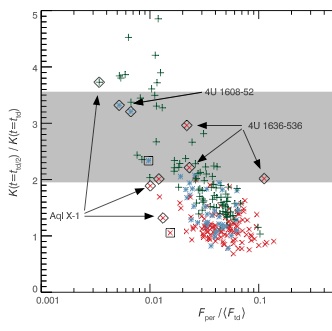Influence of accretion geometry on bursts
 One of the interesting outcomes of our
ISSI international team
on thermonuclear bursts was the work by
Juri Poutanen (U. Turku)
and his then-student
Jari Kajava (now an
ESAC research fellow),
showing that the spectral evolution during the burst proceeded in
characteristically different ways, depending upon the persistent spectral
state of the source at the time of the burst. The persistent X-rays from
burst sources arises from accretion, and these sources are found in two broad
states: hard and soft, which are thought to indicate different physical
conditions in the accretion flow. Juri's paper
(arXiv.org:1405.2663) concerned
the well-known burster and transient 4U 1608—52, while a
companion paper led by Jari
(arXiv.org:1406.0322) extended
this analysis to 10 other sources. Those who study bursts are increasingly
concerned with the interaction of bursts and the accretion environment,
and these results are helping to determine just how these two phenomena
are relatied.
Juri's paper was just accepted by MNRAS, and Jari's paper has been submitted.
One of the interesting outcomes of our
ISSI international team
on thermonuclear bursts was the work by
Juri Poutanen (U. Turku)
and his then-student
Jari Kajava (now an
ESAC research fellow),
showing that the spectral evolution during the burst proceeded in
characteristically different ways, depending upon the persistent spectral
state of the source at the time of the burst. The persistent X-rays from
burst sources arises from accretion, and these sources are found in two broad
states: hard and soft, which are thought to indicate different physical
conditions in the accretion flow. Juri's paper
(arXiv.org:1405.2663) concerned
the well-known burster and transient 4U 1608—52, while a
companion paper led by Jari
(arXiv.org:1406.0322) extended
this analysis to 10 other sources. Those who study bursts are increasingly
concerned with the interaction of bursts and the accretion environment,
and these results are helping to determine just how these two phenomena
are relatied.
Juri's paper was just accepted by MNRAS, and Jari's paper has been submitted.
Read the papers arXiv:1405.2663 & arXiv:1406.0322
Labels: 2014, thermonuclear bursts

